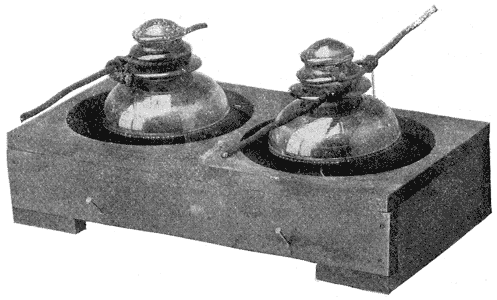[Trade Journal]
Publication: Electrical World and Engineer
New York, NY, United States
vol. 40, no. 21, p. 815, col. 1-2
"Fog Boxes" for High-Voltage Insulators.
Mr. J. J. Davis, superintendent of the United Electric Gas and Power Company, which owns a number of plants on the Pacific Coast, and has one generating station at Santa Monica, about 20 miles west of Los Angeles, offers some interesting information regarding experiences with the effect of dust and sea-fog on high-tension insulators. The power house at Santa Monica is located directly on the sea beach, and from there a 22,000-volt line supplies a number of small towns with electric light and power. The pole line for several miles of its distance is either directly on the coast or but a short distance back from it. Ever since the installation of this high-tension line, the company has experienced the greatest difficulty from current leaking over the surface of the insulators and burning off the pins. This was caused by fogs, which are very thick along this coast. It was found that the line worked perfectly iv wet weather, but in dry weather dust would accumulate under the bell of the insulator, and in time of fog, the moist atmosphere would pass under the insulators depositing moisture on the dust, which would form a sort of paste, and so establish a sufficiently low resistance path so that the high-voltage current would flash across. In a short time, the pins would burn off, with the natural result that the wire dropping on the cross-arm would burn the cross-arm off, and ultimately swing against the pole, burning it off. Mr. Davis states that the company tried many schemes to overcome this serious difficulty before he hit upon the novel device of fencing in the pins and glass. This new arrangement, he reports, has been shown by practical tests to have completely overcome the leakage, and so prevent the burning off of the pins.
 |
| "Fog Boxes" on Santa Monica Transmission Line. |
The fog box, which is illustrated herewith, is made of one-inch redwood, 12 inches square, and 4-1/4 inches deep. The box has in its top a round hole 50 inches in diameter, which leaves about 1-1/2 inches all around the outer edge of the insulators. The boxes come up within two inches of the wire, and are mounted on the cross-arm. Previous to the adoption of this scheme, there was one section of five miles of line paralleling the beach which had to be patrolled day and night. The boxes have not been in use, on part of the line, about one year.
The insulators used are the type known as No. 1 Provo, and also Locke 60,000-volts glass. The leakage was clearly not due to the fault of the insulators, because these types have been successfully used on higher voltages in other places, and in wet weather there was no trouble on this line. The trouble came with the fog after a period of dry weather. The company has experimented with insulators made for 80,000 volts working pressure, and the same trouble was experienced as with other insulators. Apparently, the boxes keep the dust and fog from drifting in under the bells of the insulators.
Mr. Davis does not consider that a transmission line at very high voltage will ever he successfully operated along a sea coast where there are fogs. To illustrate how trying the conditions are, Mr. Davis cites one case where the company had a 2,300-volt line on Locke glass insulators, made for 30,000 volts working pressure, and in a heavy sea-fog, when the insulators would get a trifle dusty, the 2.300-volt current would leak over and burn the pins. The same thing held true with Provo No. 1 insulators. When this happens with only 2,300 volts, it can easily be imagined what difficulty the company would have in operating without fog boxes on its 22,000-volt line.
